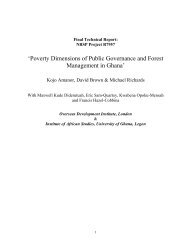Feasibility study on a capital-based income generation scheme for ...
Feasibility study on a capital-based income generation scheme for ...
Feasibility study on a capital-based income generation scheme for ...
Create successful ePaper yourself
Turn your PDF publications into a flip-book with our unique Google optimized e-Paper software.
CASH FOR RECOVERY<br />
“Save the Children pointed out that their research showed that 40% of households<br />
aren’t likely to be able to exploit enterprise opportunities as they are used to labouring<br />
and waiting <strong>for</strong> these opportunities to return – so cash grants <strong>for</strong> productive assets<br />
w<strong>on</strong>’t help them.” (Adams, 2005)<br />
For these reas<strong>on</strong>s, a livelihood recovery strategy of providing unc<strong>on</strong>diti<strong>on</strong>al large <strong>capital</strong><br />
transfers to a significant share of the not-yet-recovered households, may not be realistic. In<br />
order to assess the feasibility of this opti<strong>on</strong> with a sufficient degree of certainty, a pilot<br />
<strong>scheme</strong> in a small number of villages would have to be c<strong>on</strong>ducted. As l<strong>on</strong>g as there is no<br />
evidence supporting the feasibility of this opti<strong>on</strong>, it cannot be recommended <strong>for</strong> large-scale<br />
implementati<strong>on</strong>. It may be more appropriate <strong>for</strong> the 30 per cent of not-yet-recovered<br />
households with unemployed labour to offer their labour <strong>on</strong> the recovering labour market<br />
and/or to use the multitude of <strong>income</strong> generating programmes offered by NGOs. The ten<br />
per cent that are households lacking human <strong>capital</strong> will require <strong>income</strong>s that are not labour<br />
dependent.<br />
3.3. Supplementing/replacing in-kind asset<br />
transfers or c<strong>on</strong>diti<strong>on</strong>al <strong>capital</strong> transfers with<br />
unc<strong>on</strong>diti<strong>on</strong>al cash/<strong>capital</strong> transfers<br />
Due to time c<strong>on</strong>straints, aggravated by restricti<strong>on</strong>s to the survey team’s mobility imposed<br />
be<strong>for</strong>e and after the presidential electi<strong>on</strong>s, the team had to prioritise the number of opti<strong>on</strong>s<br />
investigated. For this reas<strong>on</strong> – and because the analysis given in Chapters 1 and 2 does not<br />
indicate that this is a high priority issue – the team has not c<strong>on</strong>ducted research into the<br />
relative benefits of supplementing or replacing the <strong>on</strong>going asset replacement programmes<br />
or c<strong>on</strong>diti<strong>on</strong>al cash transfer programmes with unc<strong>on</strong>diti<strong>on</strong>al cash/<strong>capital</strong> transfers.<br />
3.4. Capital-<strong>based</strong> transfer <strong>income</strong>s <strong>for</strong> extremely<br />
poor and labour-scarce households<br />
Despite the plethora of NGO programmes promoting labour-<strong>based</strong> ec<strong>on</strong>omic activities in<br />
Trincomalee district, no programmes tailored to the needs of labour-scarce households exist.<br />
These households were analysed in detail in Secti<strong>on</strong>2.3. The current range of livelihood<br />
recovery programmes offers them little hope.<br />
This situati<strong>on</strong> is aggravated by the ineffectiveness of existing basic social protecti<strong>on</strong><br />
programmes like Samurdhi and PAMA (see Secti<strong>on</strong> 1.3), which have not reacted to the needs<br />
created by the tsunami and which have not even started to plan <strong>for</strong> the basic social<br />
protecti<strong>on</strong> needs of those unable to achieve a sustainable livelihood. The biggest gap<br />
between needs and resp<strong>on</strong>ses is clearly faced by extremely poor households, which have little<br />
or no human <strong>capital</strong>.<br />
These households currently benefit from the GoSL and WFP transfers, which provide many<br />
with more <strong>income</strong> than they had be<strong>for</strong>e the tsunami. When these stop they will have few<br />
other <strong>income</strong> sources or assets to fall back <strong>on</strong>. Some may receive assistance from relatives, or<br />
earn small and unreliable <strong>income</strong>s from petty activities like sewing and hawking. The main<br />
30
















